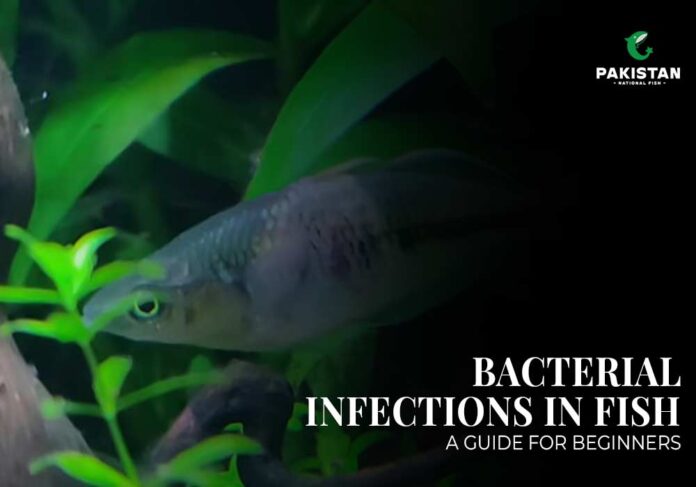Fishkeeping is a fulfilling and calming pastime activity identified by millions of populace in different parts of the globe. Nonetheless, aquatic pets’ impending care and health well-being cannot be over-emphasized. One of the most frequent and serious problems fish keepers come across are bacterial infections of the fish.
This guide is going to give the novice the crucial foundational knowledge required to spot, avoid, or even treat bacterial infections in fish.
Understanding Bacterial Infections In Fish
Infections by bacteria occur when the quantity of bacteria overwhelms the fish’s body, hence the infections. Some of these bacteria may normally be found in the aquatic environment and secrete toxins when fish is under stress, part or wholly infected, or lives in unfavorable aquatic conditions. Some members of this group are pathogenic and include; Aeromonas, Pseudomonas, Vibrio, and Flavobacterium.
Bacterial infections are quite diverse and can cause external wounds, damaged fins, or internal diseases such as fin rot. Both freshwater and marine species can be involved, meaning fish keepers of every kind must always be ready for it.
Signs Of Bacterial Infections
External Symptoms:
- Red sores or ulcers: Raw or inflamed areas of the skin where the scales have been removed or rubbed off on the fish’s body.
- Fin rot: Damaged, discolored, or worn down tail fins.
- White or grayish patches: It is one of the winter diseases, they point to likely columnaris infections.
- Swelling: Swelling or tumor-like formation which should be irregular.
- Pop-eye: Swelling of the eyelids resulting from fluid accumulation.
- Cloudy eyes: Decreased vision in the eyes or conjunctivitis meaning that an infection has occurred.
Behavioral Symptoms:
Lethargy: Lack of exercise or, in other words, no physical activity.
Loss of appetite: Refusal to eat food.
Erratic swimming: Unusual or jerky movements.
Gasping at the surface: One of the four indications of respiratory distress.
Often the Reasons for Bacterial Infections
Poor Water Quality:
- Ammonia and nitrite in levels higher than the recommended limits, excessive nitrate.
- Improper pH levels.
- Lack of good filtration or adequate aeration.
Stress:
- Overcrowding in the tank.
- Short-term fluctuation in water temperature or any other parameter.
- Aggression from other fish.
Injuries:
- Falls from tall structures carrying some decoration, touching electrical cords, wires, or other similar facilities.
- Losses from border disputes.
Nutritional Deficiency:
- A diet with inadequate amounts of vitamins and nutrients diminishes the ability of the body’s defense mechanisms.
Introduction Of Infected Fish or Equipment:
- aquaculture practices such as putting new fish into open tanks without a proper quarantine process.
- Nets or decor that are a source of bodily fluids or affected by any infectious diseases.
Preventing Bacterial Infections
The best cure is always better than the disease. Here are some general tips for reducing a tendency to get a bacterial infection:
Ensure that your surroundings are clean.
Maintain Water Quality:
- Practical advice helps when it comes to water parameters testing- undertake the testing frequently with accurate test kits. …and make water changes about 20-30% water in the aquarium once a week.
- Proliferation and accumulation of wastes should be eliminated to avert a problem; overfeeding and inefficient filters are counter-productive in this regard.
Quarantine New Additions:
- New fish should also be placed in a quarantine tank for 2- 4 weeks before they are placed in the main tank.
- Sanitize new plants, decorations, and equipment for use whenever they are bought.
Provide a Balanced Diet:
- Use premium, avowed diet brands for animal’s sake.
- Add frozen or live supplements – feed the fish with brine or bloodworms.
- Do not overfeed so that you do not have food remaining there as it may rot.
Minimize Stress:
- The last one is to never fill up the tank more than it can physically hold; otherwise, overcrowding will be inevitable.
- Pretend that fresh water is always the same temperature and do not suddenly change the temperature in it.
- People should also adapt to the environments by rearranging hiding spots and territories to lower aggression.
Regular Observation:
It is also recommended to spend some time in front of the aquarium daily in order to notice the first symptoms of the disease.
This client should be attended to if he or she displays any abnormal behavior or has an unusual appearance.
Treating Bacterial Infections
Step 1: Isolate the Affected Fish
Step 2: Improve Water Conditions
- Check and rectify the water parameters in the main tank and the new water quarantine tank.
- A partial change of water can also be done to get rid of toxins.
- Enhance the amount of dissolved oxygen so that it will contact the fish waste.
Step 3: Medicate
Employ only aquarium-safe antibiotics or antibacterial products. Popular options include:
- Broad-spectrum antibiotics: Being effective against several bacteria like Erythromycin, Kanamycin, etc.
- Specialized treatments: Predict and aim at specific bacteria for example columnaris or fin rot.
- Salt baths: For external infections treat in a separate container with aquarium salt to minimize bacterial content.
It is advisable to follow the manufacturer’s guide and avoid overusing since this will harm the fish as well as the useful bacteria.
Step 4: Monitor Progress
Step 5: Address the Underlying Cause
When to go see a professional of This special type
In some circumstances, bacterial infections can still stay with you even when you have done everything right. Consult a veterinarian experienced in fish health if:
- Symptoms get worse or de novo manifestations are identified.
- Infection is observable in many fish within the tank.
- This means that you are uncertain of the diagnosis or the treatment to offer in handling the condition.
A professional can pick more profound diagnostics, including bacterial cultures, and prescribe more potent antibiotics for a patient.


